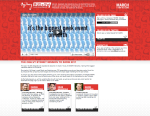How social is forcing Demand Gen to evolve.
Evolution is a remarkable thing. It sharpens yesterday’s skills to help us survive in tomorrow’s world. If you look at Demand Generation as a skill, you can trace it back to Direct Marketing, which in turn came from Direct Mail, which itself was an attempt to scale and automate Direct Selling.
Just as human evolution bred out things we no longer need (gills, for example) and enhanced things we found useful (opposable thumbs, anyone?), you can still see the core DNA of Direct Selling in a lot of what we call Demand Generation. In particular, the reliance on The List, which became so fundamental, it spun off it’s own evolutionary branch in the mid 1980’s (Database Marketing) in response to the new environment of personal computing.
So what happens to Demand Gen, and The List in particular, as it responds to the seismic shifts of, say, social media? Nobody’s entirely certain, but plenty of scientists are experimenting.
Your social behavior puts you on a list.
The likes of Kred and Klout are analysing social data to try and attribute a numeric ‘influencer score’ to individuals, ranking them in order of their ability to influence other people within certain communities or areas of interest. The obvious next step is to use these scores to create a ‘hit list’ of individuals you might want to include in a social outreach campaign, for example, and this has been marketing’s primary use of influencer scores to date, but the leap to a prospect list is still tenuous.
The list becomes a timeline.
What if we took the same principles and tried to use them to create other predictors? Such as a ‘Propensity to purchase’ model? Or a ‘time to purchase decision’ estimate? Instead of using social as a way to decide who to contact, there is potential to use social to tell us when to contact, by listening for data points that signal where on the ‘road to purchase’ someone might be. Can their ‘social signals’ tell us whether a prospect is browsing, researching, comparing or looking for a deal? The next step from here is to look for patterns over multiple engagements, to build a model that starts to predict actual timelines: real-time ‘GPS for the buyers journey’ that locates a buyers’ proximity to a decision.
The list becomes a network.
All this is ‘social scoring’ is fine in theory, but is based on the traditional B2C belief that purchases are made by an individual. The B2B world is more complex, particularly at the ‘big end of town’ were buying decisions are made by a group, operating within a hierarchy and often including people who aren’t the actual buyers. This is where the ‘network’ aspect of social networks comes into play: discovering and defining the membership of and connections within groups is the untapped data goldmine of platforms like LinkedIn. Several publishers in the B2B world are starting to mine their readership data to create ‘small world network’ models, which could be used to define these ‘buying cells’ and indicate which topics are on their collective agenda.
So, social is the new list, then?
Social is getting a lot of airplay play right now. That’s partly because it’s a shiny new toy in the marketing playpen (I wrote about this in a recent post) but mostly because it’s where your audience is spending a lot of their time and energy, in a very visible, reachable and trackable way. That fact alone should stir something in the limbic system of most marketers: you fish where the fish are.
But it doesn’t mean The List is dead. Quite the opposite: The List is evolving. There are an increasing number of increasingly sophisticated ways to build, manage, mine and generate demand from The List. And a lot of those ways are yet to be discovered, let alone perfected, which I can’t help but find exciting.















